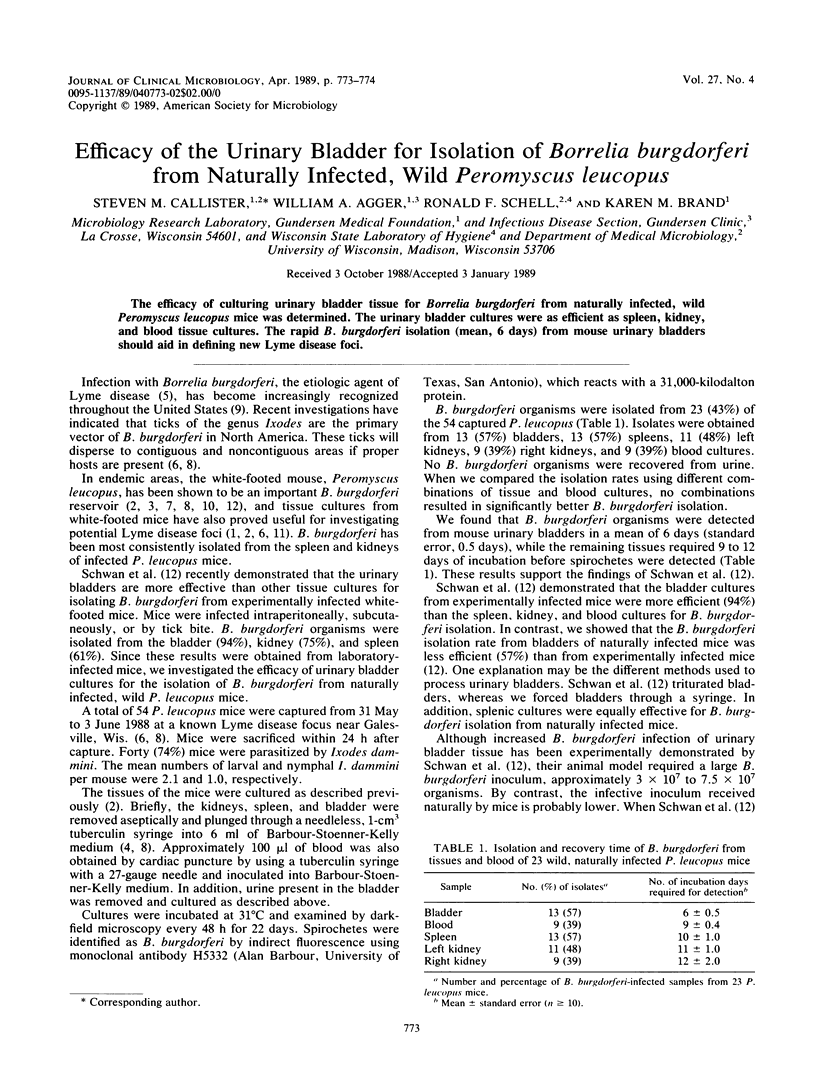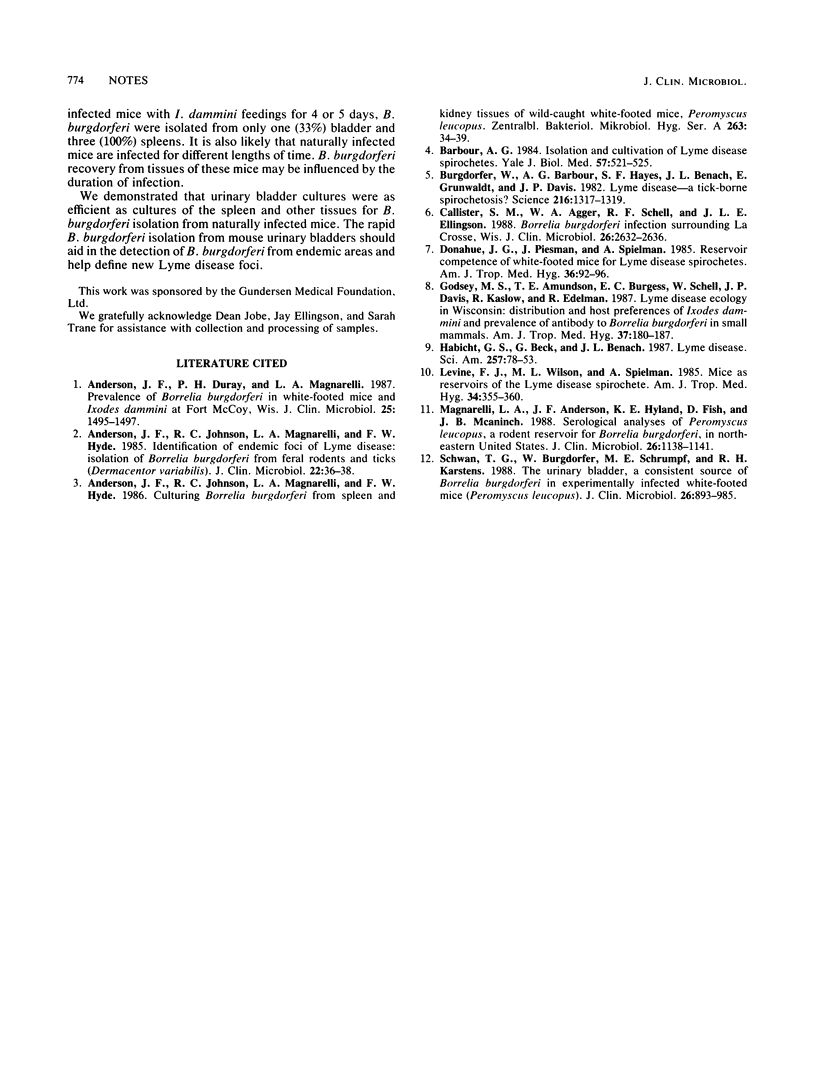Abstract
The efficacy of culturing urinary bladder tissue for Borrelia burgdorferi from naturally infected, wild Peromyscus leucopus mice was determined. The urinary bladder cultures were as efficient as spleen, kidney, and blood tissue cultures. The rapid B. burgdorferi isolation (mean, 6 days) from mouse urinary bladders should aid in defining new Lyme disease foci.
Full text
PDF

Selected References
These references are in PubMed. This may not be the complete list of references from this article.
- Anderson J. F., Duray P. H., Magnarelli L. A. Prevalence of Borrelia burgdorferi in white-footed mice and Ixodes dammini at Fort McCoy, Wis. J Clin Microbiol. 1987 Aug;25(8):1495–1497. doi: 10.1128/jcm.25.8.1495-1497.1987. [DOI] [PMC free article] [PubMed] [Google Scholar]
- Anderson J. F., Johnson R. C., Magnarelli L. A., Hyde F. W. Culturing Borrelia burgdorferi from spleen and kidney tissues of wild-caught white-footed mice, Peromyscus leucopus. Zentralbl Bakteriol Mikrobiol Hyg A. 1986 Dec;263(1-2):34–39. doi: 10.1016/s0176-6724(86)80099-2. [DOI] [PubMed] [Google Scholar]
- Anderson J. F., Johnson R. C., Magnarelli L. A., Hyde F. W. Identification of endemic foci of Lyme disease: isolation of Borrelia burgdorferi from feral rodents and ticks (Dermacentor variabilis). J Clin Microbiol. 1985 Jul;22(1):36–38. doi: 10.1128/jcm.22.1.36-38.1985. [DOI] [PMC free article] [PubMed] [Google Scholar]
- Barbour A. G. Isolation and cultivation of Lyme disease spirochetes. Yale J Biol Med. 1984 Jul-Aug;57(4):521–525. [PMC free article] [PubMed] [Google Scholar]
- Burgdorfer W., Barbour A. G., Hayes S. F., Benach J. L., Grunwaldt E., Davis J. P. Lyme disease-a tick-borne spirochetosis? Science. 1982 Jun 18;216(4552):1317–1319. doi: 10.1126/science.7043737. [DOI] [PubMed] [Google Scholar]
- Callister S. M., Agger W. A., Schell R. F., Ellingson J. L. Borrelia burgdorferi infection surrounding La Crosse, Wis. J Clin Microbiol. 1988 Dec;26(12):2632–2636. doi: 10.1128/jcm.26.12.2632-2636.1988. [DOI] [PMC free article] [PubMed] [Google Scholar]
- Donahue J. G., Piesman J., Spielman A. Reservoir competence of white-footed mice for Lyme disease spirochetes. Am J Trop Med Hyg. 1987 Jan;36(1):92–96. doi: 10.4269/ajtmh.1987.36.92. [DOI] [PubMed] [Google Scholar]
- Godsey M. S., Jr, Amundson T. E., Burgess E. C., Schell W., Davis J. P., Kaslow R., Edelman R. Lyme disease ecology in Wisconsin: distribution and host preferences of Ixodes dammini, and prevalence of antibody to Borrelia burgdorferi in small mammals. Am J Trop Med Hyg. 1987 Jul;37(1):180–187. doi: 10.4269/ajtmh.1987.37.180. [DOI] [PubMed] [Google Scholar]
- Habicht G. S., Beck G., Benach J. L. Lyme disease. Sci Am. 1987 Jul;257(1):78–83. doi: 10.1038/scientificamerican0787-78. [DOI] [PubMed] [Google Scholar]
- Levine J. F., Wilson M. L., Spielman A. Mice as reservoirs of the Lyme disease spirochete. Am J Trop Med Hyg. 1985 Mar;34(2):355–360. doi: 10.4269/ajtmh.1985.34.355. [DOI] [PubMed] [Google Scholar]
- Magnarelli L. A., Anderson J. F., Hyland K. E., Fish D., Mcaninch J. B. Serologic analyses of Peromyscus leucopus, a rodent reservoir for Borrelia burgdorferi, in northeastern United States. J Clin Microbiol. 1988 Jun;26(6):1138–1141. doi: 10.1128/jcm.26.6.1138-1141.1988. [DOI] [PMC free article] [PubMed] [Google Scholar]
- Schwan T. G., Burgdorfer W., Schrumpf M. E., Karstens R. H. The urinary bladder, a consistent source of Borrelia burgdorferi in experimentally infected white-footed mice (Peromyscus leucopus). J Clin Microbiol. 1988 May;26(5):893–895. doi: 10.1128/jcm.26.5.893-895.1988. [DOI] [PMC free article] [PubMed] [Google Scholar]


